Jasper Lake Fanless Showdown: ECS LIVA Z3 and ZOTAC ZBOX CI331 nano UCFF PCs Review
by Ganesh T S on July 8, 2022 8:30 AM EST- Posted in
- Systems
- ZOTAC
- Fanless
- ECS
- Passive Cooling
- UCFF
- Mini-PC
- Jasper Lake
System Performance: Miscellaneous Workloads
Standardized benchmarks such as UL's PCMark 10 and BAPCo's SYSmark take a holistic view of the system and process a wide range of workloads to arrive at a single score. Some systems are required to excel at specific tasks - so it is often helpful to see how a computer performs in specific scenarios such as rendering, transcoding, JavaScript execution (web browsing), etc. This section presents focused benchmark numbers for specific application scenarios.
3D Rendering - CINEBENCH R23
We use CINEBENCH R23 for 3D rendering evaluation. R23 provides two benchmark modes - single threaded and multi-threaded. Evaluation of different PC configurations in both supported modes provided us the following results.
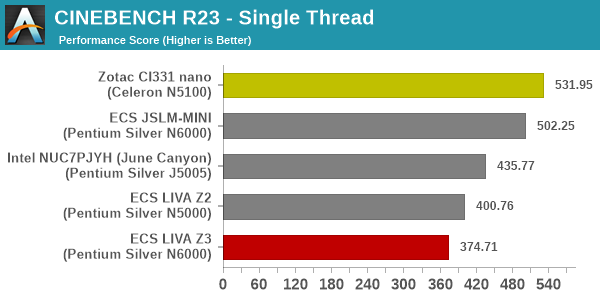

The ZOTAC CI331 nano, with its PL1 limit set to 7W, while the LIVA Z3 / JSLM-MINI have it at 6W. Coupled with the thermal throttling in the LIVA Z3, it is no surprise that the CI331 nano comes out on top in the single-threaded case despite its lower advertised clocks. The JSLM-MINI leaves the Z3 behind due to the thermal throttling issue. With multiple threads in the picture, the actively cooled June Canyon NUC with its higher power budget takes the crown.
Transcoding: Handbrake 1.5.1
Handbrake is one of the most user-friendly open source transcoding front-ends in the market. It allows users to opt for either software-based higher quality processing or hardware-based fast processing in their transcoding jobs. Our new test suite uses the 'Tears of Steel' 4K AVC video as input and transcodes it with a quality setting of 19 to create a 720p AVC stream and a 1080p HEVC stream.
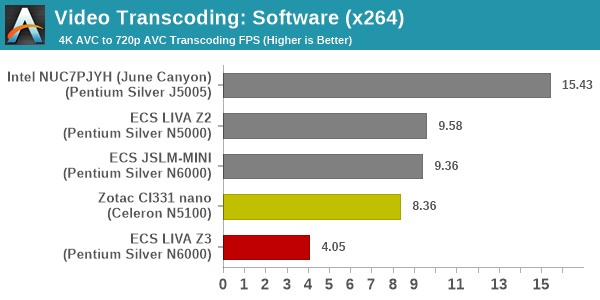
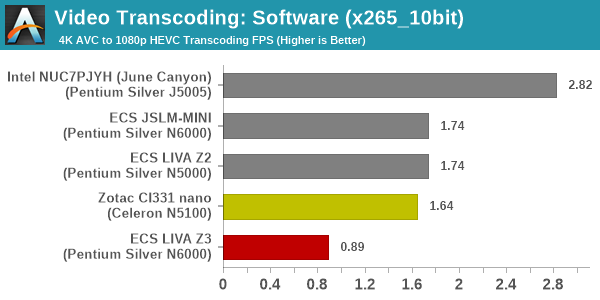
The factors influencing the software transcoding rate are power budget and core count. While the latter is the same for all systems (four cores with one thread per core), the power budget for the June Canyon and its active cooling (allowing it to maintain 10W throughout) help it in coming out on top. The ZBOX suffers slightly in this sustained loading test. As we shall see in a later section, the system is not up to the task of sustaining 7W over extended durations.
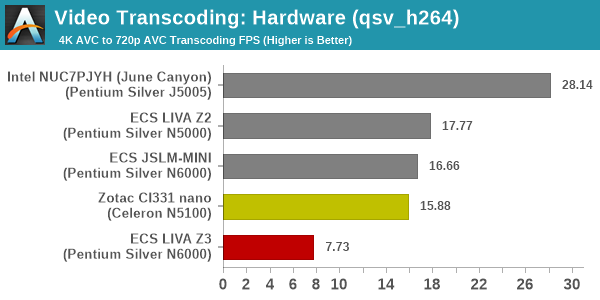
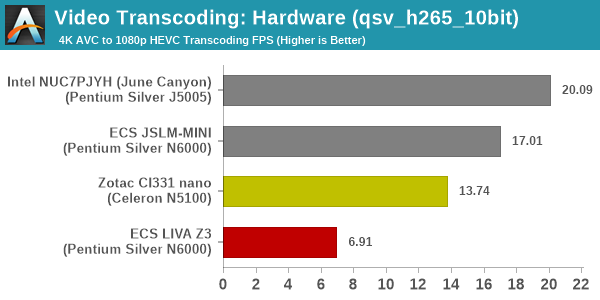
Hardware-accelerated transcoding rates are a function of GPU clock rates and power budget. The actively-cooled Gemini Lake system with its higher iGPU power budget leads the pack. The close numbers for LIVA Z2 and JSLM-MINI for AVC encoding show that the QuickSync engine itself doesn't have performance improvements in going from Gemini Lake to Jasper Lake. The Z3 and the CI331 nano both appear to be throttled in the HEVC transcoding test.
Archiving: 7-Zip 21.7
The 7-Zip benchmark is carried over from our previous test suite with an update to the latest version of the open source compression / decompression software.
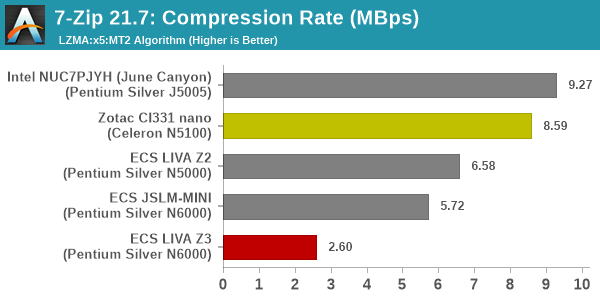

Power budget matters for the relatively short-running 7-Zip benchmark. Ignoring the actively-cooled June Canyon, we see the 7W PL1 limit of the CI331 nano helping it to lead the pack among the passively-cooled systems.
Web Browsing: JetStream, Speedometer, and Principled Technologies WebXPRT4
Web browser-based workloads have emerged as a major component of the typical home and business PC usage scenarios. For headless systems, many applications based on JavaScript are becoming relevant too. In order to evaluate systems for their JavaScript execution efficiency, we are carrying over the browser-focused benchmarks from the WebKit developers used in our notebook reviews. Hosted at BrowserBench, JetStream 2.0 benchmarks JavaScript and WebAssembly performance, while Speedometer measures web application responsiveness.
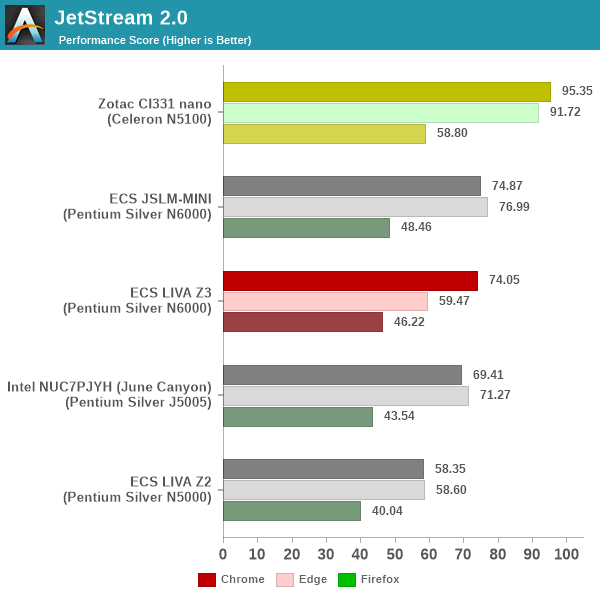
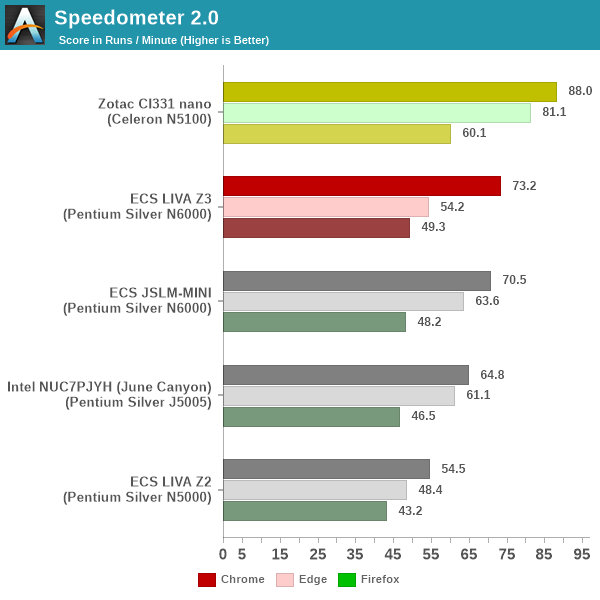
From a real-life workload perspective, we also process WebXPRT4 from Principled Technologies. WebXPRT4 benchmarks the performance of some popular JavaScript libraries that are widely used in websites.
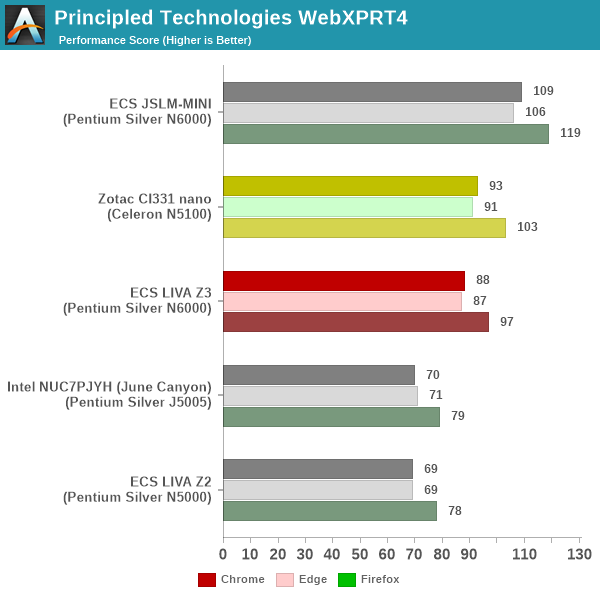
The microarchitectural improvements in Jasper Lake come to the fore in these benchmarks. Despite the higher power budget and active cooling, the June Canyon NUC with a 10W Gemini Lake processor is left well behind by all the passively-cooled Jasper Lake systems. WebXPRT4, in particular, is long-running and reflective of typical web browser usage. The fact that the fanless systems still come out with better scores despite any thermal throttling reflects well on the improvements in Tremont over Goldmont Plus.
Application Startup: GIMP 2.10.30
A new addition to our systems test suite is AppTimer - a benchmark that loads up a program and determines how long it takes for it to accept user inputs. We use GIMP 2.10.30 with a 50MB multi-layered xcf file as input. What we test here is the first run as well as the cached run - normally on the first time a user loads the GIMP package from a fresh install, the system has to configure a few dozen files that remain optimized on subsequent opening. For our test we delete those configured optimized files in order to force a fresh load every second time the software is run.
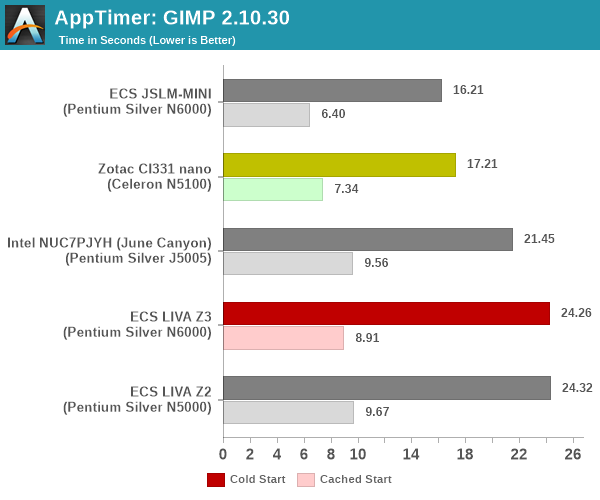
As it turns out, GIMP does optimizations for every CPU thread in the system, which requires that higher thread-count processors take a lot longer to run. So the test runs quick on systems with fewer threads, however fast cores are also needed. The thread count for all processors are the same in the considered systems. Since it boils down to fast cores, the power budget and the ability to sustain it helps. As we shall see in a later section, the JSLM-MINI is the least susceptible to thermal throttling, and that works in its favor.










52 Comments
View All Comments
mode_13h - Tuesday, July 19, 2022 - link
BTW, I'm seeing Supermicro (DDR5) W680 boards now in stock! Unfortunately, I can't say the same for DDR5-4800 Unbuffered ECC DIMMs. It's good that I'm in no hurry.Oxford Guy - Tuesday, July 12, 2022 - link
'After suspecting thermal throttling due to the lack of convective cooling for the thermal module, we decided to repeat all the benchmarking for the bare board - i.e, with the top of the chassis removed and the DMICs / WLAN functionality discarded.'What is this nonsense?
You test the product the way it is designed and sold. If it's designed by idiots it deserves the review it gets.
Oxford Guy - Tuesday, July 12, 2022 - link
ECS knows what ventilation slots are. The first model of Liva has them on the top, bottom, and sides of the unit!ganeshts - Tuesday, July 12, 2022 - link
That is pretty much what I wanted to do, but I ran the numbers just to prove to ECS that it is their chassis that is the problem, and not the internal thermal module. (Typically, we have a back-and-forth with the vendor in case things aren't performing as expected, just to make sure they can reproduce the issue on their side too).So, once I had the results, I decided to just include it in the review to show readers that the problems lie with the case.
mode_13h - Wednesday, July 13, 2022 - link
> I ran the numbers just to prove to ECS that it is their chassis that is the problemAnd thank you for doing it. Testing as-sold is fine, and those numbers should be the main ones reported. However, supplemental testing to investigate suspected design flaws is the mark of a quality reviewer.
Keep up the good work!
Oxford Guy - Saturday, July 16, 2022 - link
Zen 1 and 2, tested with JEDEC slowwww RAM and not also with any XMP profiles.LIVA Z3 tested without its case and one of its main parts.
I guess removing the protective case and the wireless Internet of a computer is more normal ordinary user behavior than turning on XMP in BIOS.
Just trying to understand the big picture here...
Oxford Guy - Saturday, July 16, 2022 - link
And, of course, that continues:‘As a result, in lieu of CPU overclocking, the biggest thing a user can do to influence higher performance with the Ryzen 7 5800X3D is to use faster DDR4 memory with lower latencies, such as a good DDR4-3600 kit. These settings are also the known sweet spot for AMD's Infinity Fabric Interconnect as set out by AMD.’
proceeds to test with 3200-speed RAM...
mode_13h - Sunday, July 17, 2022 - link
> LIVA Z3 tested without its case and one of its main parts.Yes, but only supplementing their testing in its baseline "as-sold" config. You really ought to go back and re-read stuff before rage-posting about it.
"The numbers for this configuration are referenced using ECS JSLM-MINI (the motherboard's model name) in the relevant sections."
Where data from this configuration is posted, you'll see *both* ECS LIVA Z3 *and* ECS JSLM-MINI, showing just how much the Z3 is hurt by the poor airflow of its chassis.
Oxford Guy - Sunday, July 17, 2022 - link
'You really ought to go back and re-read stuff before rage-posting about it.'Your usual ad hom routine won't change this interesting inconsistency.
mode_13h - Sunday, July 17, 2022 - link
> Your usual ad hom routineNo, you're flat-out wrong. Trying to shift the subject back on me won't change that. I'd almost feel bad for you embarrassing yourself like this, but you never seem to tire of reminding us what an unpleasant person you are.
FYI: the correct response, when you've been caught leveling a false allegation is: "Oops. Sorry." Anything else just makes it worse.